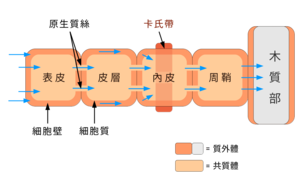凯氏带


凯氏带迫使水分从内皮層细胞开始只能通过共质体途径继续运输
凯氏带(Casparian strip),橫切面稱為凯氏點(Casparian dot)[1],是維管束植物(蕨類[2] 與種子植物)根部内皮层細胞壁(径向壁和横向壁)中央的带状增厚區域,其成分主要為木質素,宽度随物種不同而異。因卡氏帶不透水,可控制皮層和维管束之间的水分與無機鹽运输,阻止水分與無機鹽經質外體運送至中柱,使其必須進入細胞膜內改以共質體途徑前往中柱,故有阻擋細胞內外物質運輸的作用,功能與動物組織中的緊密連接類似[3][4]。卡氏帶的發育受SHORT-ROOT(SHR)、SCARECROW(SCR)與MYB36等轉錄因子以及中柱細胞合成的多肽激素調控[5][6]。
發現
[编辑]卡氏帶的發現可回溯至19世紀中葉,對植物根部内皮层認識的進展[7]。1865年,德国植物学家羅伯·凯斯伯里首次描述了植物根部的内皮层,發現其細胞壁有加厚的現象,並將其命名為「Schutzscheide」(意指防護套),後來學者將其加厚的部分稱為卡氏帶,即得名自凯斯伯里[4][8]。1870年代文獻中即出現「凯氏點」(德語:Caspary'schen fleck)一詞[9][10],二十世紀以後則多稱為「卡氏帶」(德語:Casparyschen streifen)。1922年研究人員首度自植物根部分離了卡氏帶以研究其成分[11][12]。
成分
[编辑]凯氏带的化學成分長期有所爭議,凯斯伯里即指出此構造可能為木質素或木栓質組成,後來的學者大多認為是木栓質,直到1990年代才有研究在分析數種植物的卡氏帶後,發現木質素才是其主要成分[13],但許多教科書仍未更新[3]。內皮層的細胞壁雖富含木栓質,不過此為內皮層次級分化的結果[註 1],過去有學者認為卡氏帶的形成即為次級分化的開端,實則兩者無直接關係,卡氏帶在內皮層初級分化後便已形成,且次級分化是由根的弦切面開始,而非卡氏帶所在的橫切面和徑切面[2]。
功能
[编辑]凯氏带完全填充了內皮細胞間包含中膠層在內的空隙,使兩細胞的細胞壁幾乎融合[2]。在植物根部水與無機養分的運輸中,凯氏带主要影響質體外運輸途徑,即水與無機鹽經表皮與皮層細胞壁間質傳遞的運輸。水與無機鹽來到內皮層細胞時,因卡氏帶不透水而需轉而通過細胞膜進入細胞內,改以共質體途徑運輸才得以到達中柱的木質部細胞,進而輸往莖葉等其他器官[8]。當生長環境不利時,卡氏帶可作為植物細胞與外界的屏障,避免環境中的離子進入或自身離子的流出[6]。此外卡氏帶與內皮層的木栓加厚還有阻擋有毒物質或病原入侵,以及防止水分散逸的功能[14]。有研究顯示植物在高鹽的環境下可能會形成更厚的卡氏帶,且在更靠近根尖的區域即有卡氏帶形成,這可能是對環境的一項適應[15][16],但相較於內皮層次級分化的木栓壁在高鹽逆境下會大幅加厚,卡氏帶的改變相對較小[17]。
凯氏带主要位於根的内皮层,不過有些植物在根部皮層外側的外皮層[18]、茎或叶中也有卡氏帶[19],例如白皮松的針葉與天竺葵的莖中皆有卡氏帶,可能與防止水分散失或病原入侵有關[20][21]。
發育
[编辑]
凯氏带的發育在內皮層細胞充分延展後開始[13][22],目前已知兩條促進內皮層細胞形成凯氏带的訊息傳遞路徑,第一條為轉錄因子SHORT-ROOT(SHR)激活另外兩種轉錄因子MYB36與SCARECROW(SCR),前者可刺激卡氏帶蛋白(casparian strip proteins,CASP1-5)、過氧化物酶64(PER64)及ESB1(enhanced suberin 1)等與卡氏帶發育相關的蛋白表現,後者則影響卡氏帶在內皮層細胞的位置,其突變會導致卡氏帶的位置過於靠近中柱[5];第二條則為中柱細胞合成的兩種多肽激素凯氏带完整因子1與2(casparian strip integrity factor;CIF1-2)與內皮層細胞径向壁和横向壁的GSO1(SGN3)及GSO2受體結合,促使原本散播在細胞中的CASP集中到與將形成卡氏帶的位置對應的細胞膜區域[6],形成卡氏帶膜結構域(casparian strip membrane domain,CSD),CSD初形成時為數個不連續的區域,GS01受體則環繞在各CSD區域的邊緣,促進CSD融合成一個連續的帶狀區域,即為將要形成卡氏帶的區域[23]。
卡氏帶蛋白為膜蛋白,彼此間有交互作用,並可再與PER64、ESB1和呼吸爆發氧化酶同源物F(RBOHF)等合成木質素所需的蛋白結合以啟動卡氏帶發育的下游反應[2][4]。缺乏GSO1受體或同時缺乏CIF1與CIF2多肽的突變植株中,CASP1在內皮層細胞膜上分布異常,CSD無法正常融合成連續完整的帶狀結構,因而最終形成破碎而不連續的卡氏帶[6][23]。
光照、土壤鹽分與缺水逆境等環境因子均會影響卡氏帶的發育[20]。
圖集
[编辑]註腳
[编辑]參考文獻
[编辑]- ^ Pandey, B. P. A Textbook of Botany: Angiosperms. S. Chand Publishing. 2001: 445 [2021-04-18]. ISBN 978-81-219-0404-9. (原始内容存档于2021-05-10).
- ^ 2.0 2.1 2.2 2.3 2.4 Geldner, N. The Endodermis. Annual Review of Plant Biology. 2013, 64 (1): 531–558. ISSN 1543-5008. doi:10.1146/annurev-arplant-050312-120050.
- ^ 3.0 3.1 Geldner, N. Casparian strips (PDF). Current Biology. 2013, 23.
- ^ 4.0 4.1 4.2 Roppolo, D.; De Rybel, B.; Tendon, V. D.; Pfister, A.; Alassimone, J.; Vermeer, J. E. M.; Yamazaki, M.; Stierhof, Y.-D.; Beeckman, T.; Geldner, N. A novel protein family mediates Casparian strip formation in the endodermis. Nature. 2011, 473 (7347): 380–383. ISSN 0028-0836. doi:10.1038/nature10070.
- ^ 5.0 5.1 Li, P.; Yu, Q.; Gu, X.; Xu, C.; Qi, S.; Wang, H.; et al. Construction of a Functional Casparian Strip in Non-endodermal Lineages Is Orchestrated by Two Parallel Signaling Systems in Arabidopsis thaliana. Current Biology. 2018, 28 (17): 2777–2786.e2 [2021-04-17]. PMID 30057307. doi:10.1016/j.cub.2018.07.028. (原始内容存档于2021-04-17).
- ^ 6.0 6.1 6.2 6.3 Nakayama, T.; Shinohara, H.; Tanaka, M.; Baba, K.; Ogawa-Ohnishi, M.; Matsubayashi, Y. A peptide hormone required for Casparian strip diffusion barrier formation in Arabidopsis roots.. Science. 2017, 355 (6322): 284–286 [2021-04-17]. PMID 28104889. doi:10.1126/science.aai9057. (原始内容存档于2021-04-17).
- ^ Seago, J. L., Jr. Revisiting the occurrence and evidence of endodermis in angiosperm shoots. Flora. 2020, 273: 151709 [2021-04-23]. doi:10.1016/j.flora.2020.151709. (原始内容存档于2021-05-10).
- ^ 8.0 8.1 Grebe, M. Unveiling the Casparian strip. Nature. 2011, 473 (7347): 294–295. ISSN 0028-0836. doi:10.1038/473294a.
- ^ Russow, E. Rhizocarpeae. I. Axenorgane: A. Stamm: a. Marsilia (Drummondii, elata, salvatrix). Vergleichende Untersuchungen betreffend die Histiologie (Histiographie und Histiogenie) der vegetativen und Sporen-bildenden Organe und die Entwickelung der Sporen der Leitbündel-Kryptogamen: mit Berücksichtigung der Histiologie der Phanerogamen, ausgehend von der Betrachtung der Marsiliaceen. Commissionnaires de l'Académie Impériale des sciences. 1872: 1–12 [2021-04-18]. (原始内容存档于2021-05-10).
- ^ Müller, C. Morphologie der Gewebe. Just's Botanischer Jahresbericht. 1884, 12 (1): 234–342 [2021-04-18]. (原始内容存档于2021-05-10).
- ^ Priestley, J. H.; North, E. E. Physiological Studies in Plant Anatomy III. The Structure of the Endodermis in Relation to its Function. The New Phytologist. 1922, 21 (3): 113-139 [2021-04-18]. (原始内容存档于2021-05-10).
- ^ Song, C.; Shen, W.; Du, L.; Wen, J.; Lin, J.; Li, R. Development and chemical characterization of Casparian strips in the roots of Chinese fir (Cunninghamia lanceolata). Trees. 2019, 33 (3): 827–836. ISSN 0931-1890. doi:10.1007/s00468-019-01820-x.
- ^ 13.0 13.1 Naseer, S.; Lee, Y.; Lapierre, C.; Franke, R.; Nawrath, C.; Geldner, N. Casparian strip diffusion barrier in Arabidopsis is made of a lignin polymer without suberin.. Proceedings of the National Academy of Sciences. 2012, 109 (25): 10101–6. PMC 3382560
 . PMID 22665765. doi:10.1073/pnas.1205726109.
. PMID 22665765. doi:10.1073/pnas.1205726109.
- ^ Robbins, N. E.; Trontin, C.; Duan, L.; Dinneny, J. R. Beyond the barrier: communication in the root through the endodermis.. Plant Physiology. 2014, 166 (2): 551–9. PMC 4213087
 . PMID 25125504. doi:10.1104/pp.114.244871.
. PMID 25125504. doi:10.1104/pp.114.244871.
- ^ Karahara, I.; Ikeda, A.; Kondo, T.; Uetake, Y. Development of the Casparian strip in primary roots of maize under salt stress. Planta. 2004, 219 (1): 41–7. PMID 14986139. doi:10.1007/s00425-004-1208-7.
- ^ Chen, T.; Cai, X.; Wu, X.; Karahara, I.; Schreiber, L.; Lin, J. Casparian strip development and its potential function in salt tolerance.. Plant Signaling & Behavior. 2011, 6 (10): 1499–502. PMC 3256377
 . PMID 21904117. doi:10.4161/psb.6.10.17054.
. PMID 21904117. doi:10.4161/psb.6.10.17054.
- ^ Palmgren, M. Plant epithelia: What is the role of the mortar in the wall?. PLOS Biology. 2018, 16 (12): e3000073. PMC 6296743
 . PMID 30517104. doi:10.1371/journal.pbio.3000073.
. PMID 30517104. doi:10.1371/journal.pbio.3000073.
- ^ Evert, R. F. Esau's Plant Anatomy: Meristems, Cells, and Tissues of the Plant Body: Their Structure, Function, and Development. John Wiley & Sons. 2006-08-28: 6 [2021-04-17]. ISBN 978-0-470-04737-8. (原始内容存档于2020-12-01).
- ^ Lersten, N. R. Occurrence of endodermis with a casparian strip in stem and leaf. The Botanical Review. 1997, 63 (3): 265–272. ISSN 0006-8101. doi:10.1007/BF02857952.
- ^ 20.0 20.1 Wu, X.; Lin, J.; Lin, Q.; Wang, J.; Schreiber, L. Casparian Strips in Needles are More Solute Permeable than Endodermal Transport Barriers in Roots of Pinus bungeana. Plant and Cell Physiology. 2005, 46 (11): 1799–1808. ISSN 1471-9053. doi:10.1093/pcp/pci194.
- ^ Meyer, C. J.; Peterson, C. A. Casparian bands occur in the periderm of Pelargonium hortorum stem and root. Annals of Botany. 2011, 107 (4): 591–8. PMC 3064534
 . PMID 21239408. doi:10.1093/aob/mcq267.
. PMID 21239408. doi:10.1093/aob/mcq267.
- ^ Barberon, M. The endodermis as a checkpoint for nutrients. New Phytologist. 2017, 213 (4): 1604–1610. PMID 27551946. doi:10.1111/nph.14140.
- ^ 23.0 23.1 Pfister, A.; Barberon, M.; Alassimone, J.; Kalmbach, L.; Lee, Y.; Vermeer, J. E. M.; et al. A receptor-like kinase mutant with absent endodermal diffusion barrier displays selective nutrient homeostasis defects. eLife. 2014, 3: e03115 [2021-04-17]. PMC 4164916
 . PMID 25233277. doi:10.7554/eLife.03115. (原始内容存档于2021-04-17).
. PMID 25233277. doi:10.7554/eLife.03115. (原始内容存档于2021-04-17).



